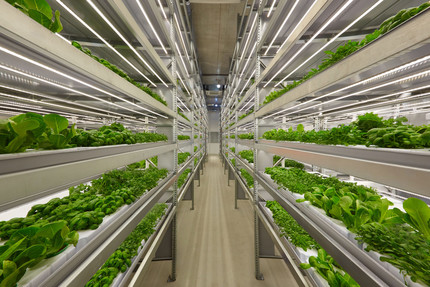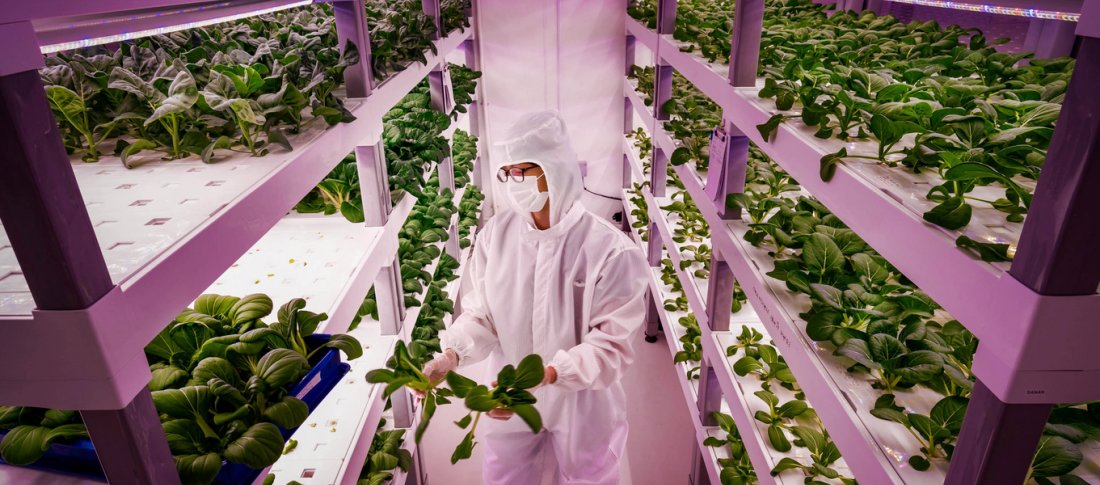You’ve probably seen the term ‘vertical farming’ in the news and on social media lately, but if you’re not sure what it’s all about, you wouldn’t be alone. With challenges in food supply bought about with the Coronavirus pandemic and Brexit over the last 18 months or so, the practice has really started taking off here in the UK, and globally. So we thought it was time to take a closer look.
What is vertical farming?
Remove all visions you may have of your dairy cows being stacked on top of each other in the parlour, vertical farming is actually the practice of growing plant crops indoors in a series of stacked layers. It involves carefully controlling all growing conditions for the crops according to the stage they are at in their growth cycle.
Unlike glasshouses, where light is primarily provided by the sun, vertical farms rely solely on artificial LED lighting. Added to this, soil-free growing techniques and environmental control systems mean that vertical farming is a highly specialised practice.
The opportunities afforded by vertical farming
There are some clear merits attached to the practice of vertical farming, which make it a worthy consideration going forwards.
From a sustainability and food security perspective, vertical farming offers the UK the opportunity to maintain a greater proportion of its own food supplies, reducing our reliance on imports and slashing food miles. While this is of no direct significance to the dairy industry, the benefit for growers of quick-to-market fruit, vegetables and herbs is sure to positively impact agriculture as a whole. It also offers greater traceability, providing consumers with increased assurance of the origin of their food. More easily calculated yields also mean reduced food wastage.
With water, light and fertigation precisely managed and chemical treatments rarely used, it could help combat some of the industry’s difficulties with pollution and water use as well as the challenges arising from extreme weather events. Vertical farming uses 95% less water than traditional farming practices and offers greater opportunity for organically produced food.
The stacking system means that relatively minimal land area is required for large volumes of food production, meaning that food can be produced in confined or urban areas within the community or region it is intended.
The artificial intelligence technology developed to manage vertical farming enterprises could be of benefit to the wider agricultural industry in the future. There is already uptake of the technology in other segments of the indoor farming sector such as in greenhouses, to enhance their productivity.

The challenges arising from vertical farming
As with any farming practice, vertical farming throws up its own set of challenges, which are worth factoring in before deciding on its viability.
The energy required for artificial lighting and ventilation of vertical farms is a consideration not to be ignored. Combine these with the initial investment required to get a vertical farm out of the ground and the costs really do stack up.
These costs will need to be passed on to someone, so clear justification will be required to persuade the consumer of the merits of vertically farmed crops over cheaper, field-grown crops.
As with any crop, there’s the challenge of meeting seasonal fluctuations in consumer demand. With vertical farms able to produce the same volumes year-round, the question of how to meet extreme increases in demand might arise.
The future of vertical farming
Vertical farming is taking off at an exciting rate, with a forecasted 25% growth in the next decade, globally. With an estimated 68% of the world population living in urban areas by 2050, there will be increased pressure on rural land and a higher demand for food, which the practice could easily combat.
With increased uptake and the potential for fully automated robotic farming aligned with the fast development of AI and machine learning over the next five years, the cost of indoor production should plummet. In addition, the occupational hazards associated with traditional farming could be significantly lessened with reduced exposure to large farm equipment, poisonous chemicals, and disease.
With vertical farming technologies still relatively new there are still plenty of challenges ahead, particularly in regards to the economics, but the performance of existing vertical farms will determine to a degree, the role the practice will play in the future.
